Serving 801 students in grades 5-8, Middle School At Parkside ranks in the bottom 50% of all schools in New Hampshire for overall test scores (math proficiency is bottom 50%, and reading proficiency is bottom 50%).
The percentage of students achieving proficiency in math is 9% (which is lower than the New Hampshire state average of 40%). The percentage of students achieving proficiency in reading/language arts is 26% (which is lower than the New Hampshire state average of 51%).
The student:teacher ratio of 10:1 is lower than the New Hampshire state level of 11:1.
Minority enrollment is 54% of the student body (majority Hispanic), which is higher than the New Hampshire state average of 18% (majority Hispanic and Asian).
Quick Stats (2025)
- Grades: 5-8
- Enrollment: 801 students
- Student:Teacher Ratio: 10:1
- Minority Enrollment: 54%
- Overall Testing Rank: Bottom 50% in NH
- Math Proficiency: 9% (Btm 50%)
- Reading Proficiency: 26% (Btm 50%)
- Science Proficiency: 14% (Btm 50%)
- Source: National Center for Education Statistics (NCES), NH Dept. of Education
Top Rankings
Middle School At Parkside ranks among the top 20% of public schools in New Hampshire for:
Category
Attribute
Diversity
Percent Eligible For Free Lunch
School Overview
Middle School At Parkside's student population of 801 students has grown by 22% over five school years.
The teacher population of 84 teachers has grown by 40% over five school years.
Grades Offered
Grades 5-8
Total Students
801 students
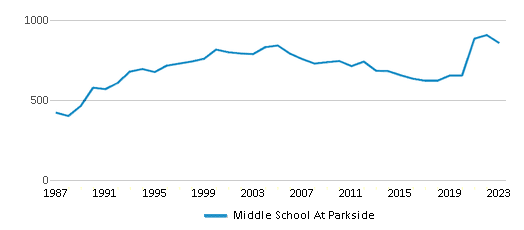
Gender %
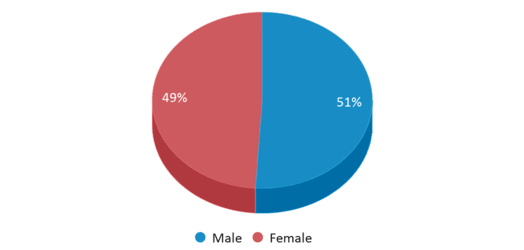
Total Classroom Teachers
84 teachers
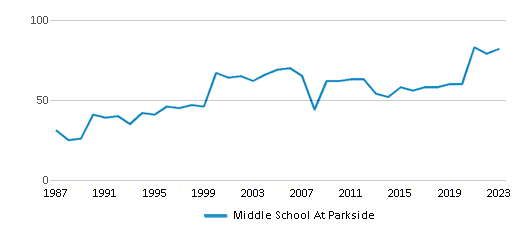
Students by Grade
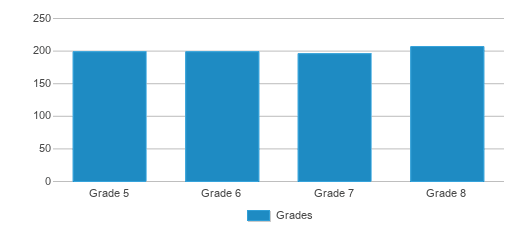
School Rankings
Middle School At Parkside ranks within the bottom 50% of all 457 schools in New Hampshire (based off of combined math and reading proficiency testing data).
The diversity score of Middle School At Parkside is 0.69, which is more than the diversity score at state average of 0.32. The school's diversity has stayed relatively flat over five school years.
Overall Testing Rank
#450 out of 457 schools
(Bottom 50%)
(Bottom 50%)
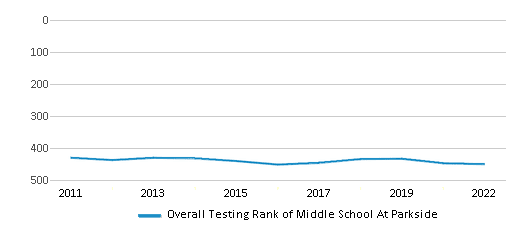
Math Test Scores (% Proficient)
9%
40%
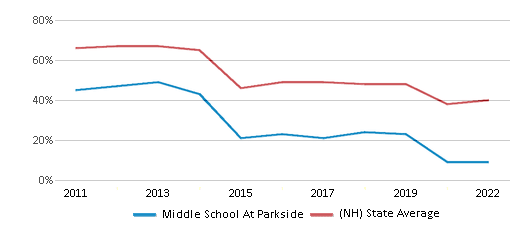
Reading/Language Arts Test Scores (% Proficient)
26%
51%
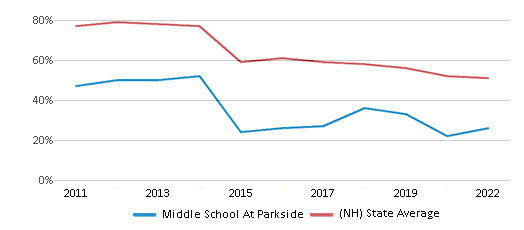
Science Test Scores (% Proficient)
14%
36%
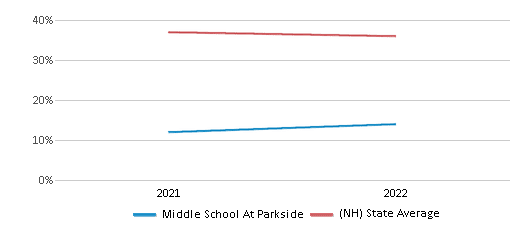
Student : Teacher Ratio
10:1
11:1
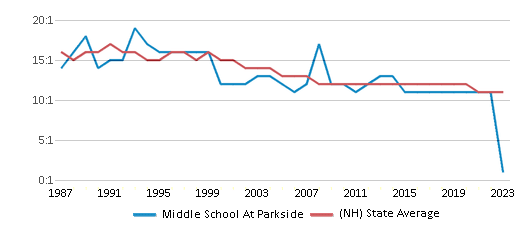
American Indian
n/a
n/a
Asian
3%
3%
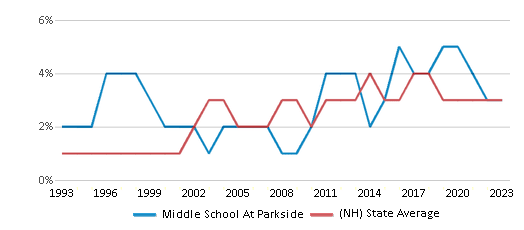
Hispanic
29%
8%
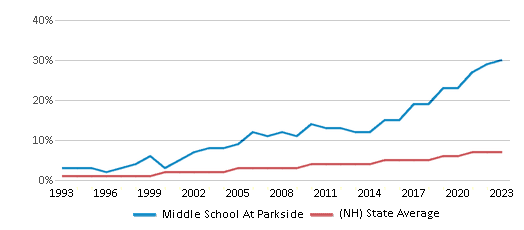
Black
9%
2%
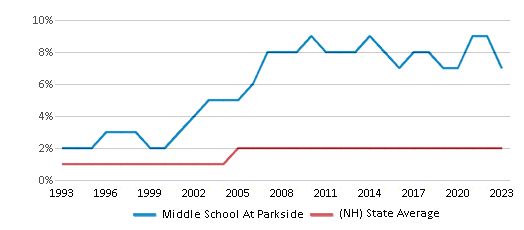
White
46%
82%
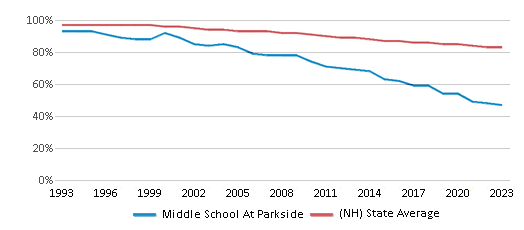
Hawaiian
n/a
n/a
Two or more races
13%
5%
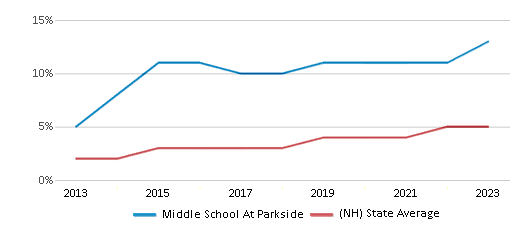
All Ethnic Groups
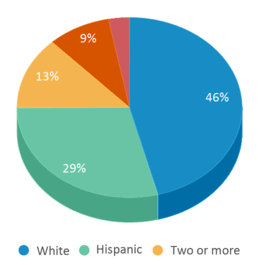
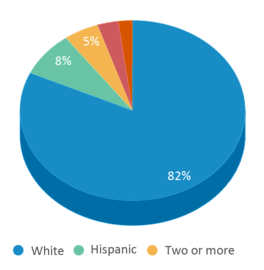

Participates in the National School Lunch Program (NSLP)
Yes
Eligible for Free Lunch
49%
20%
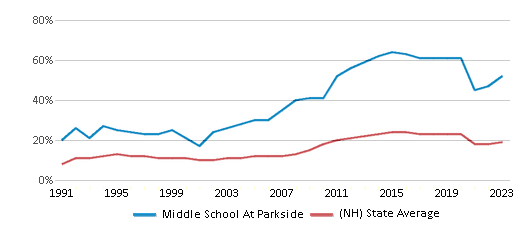
Eligible for Reduced Lunch
6%
4%
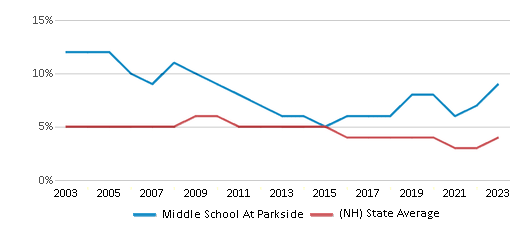
School District Name
Source: National Center for Education Statistics (NCES), NH Dept. of Education
Profile last updated: 02/09/2025
Frequently Asked Questions
What is Middle School At Parkside's ranking?
Middle School At Parkside is ranked #450 out of 457 schools, which ranks it among the bottom 50% of public schools in New Hampshire.
What schools are Middle School At Parkside often compared to?
Middle School At Parksideis often viewed alongside schools like Hillside Middle School by visitors of our site.
What percent of students have achieved state testing proficiency in math and reading?
9% of students have achieved math proficiency (compared to the 40% NH state average), while 26% of students have achieved reading proficiency (compared to the 51% NH state average).
How many students attend Middle School At Parkside?
801 students attend Middle School At Parkside.
What is the racial composition of the student body?
46% of Middle School At Parkside students are White, 29% of students are Hispanic, 13% of students are Two or more races, 9% of students are Black, and 3% of students are Asian.
What is the student:teacher ratio of Middle School At Parkside?
Middle School At Parkside has a student ration of 10:1, which is lower than the New Hampshire state average of 11:1.
What grades does Middle School At Parkside offer ?
Middle School At Parkside offers enrollment in grades 5-8
What school district is Middle School At Parkside part of?
Middle School At Parkside is part of Manchester School District.
School Reviews
4 1/20/2020
I have no complaints at all about this school. It is one of the best-kept secrets.
4 9/9/2017
I must come to this school's defense. I have heard a lot of negative comments about Middle School at Parkside the year my son was slated to become a 6th grader there. He is now in 8th Grade. I have absolutely NOTHING bad to say about this school what so ever. On the contrary actually, I have not met one educator on this staff that hasn't been anything but helpful. There has never been a time when I have had an inquiry, or a concern that my concerns were not met with the utmost expedience and attention to the matter. There will always be some trouble in ALL schools, and being in a big city, there again, will always be some things that concern us. But rather than parents gossiping among themselves, communicate with the Staff. I cannot believe that I am the only parent that actually thinks the teachers and faculty at parkside middle school are doing a great job, especially with the work load handed to them and the amount of children that they are educating. Thank you Forrest Ransdall (Principal) and the entire faculty at Parkside that have made this a positive experience. It is my sons last year at Parkside, and I will be passing on good reviews onto any other parents that may ask me my opinion.
5 5/12/2014
I LOVE THIS SCHOOL AND ALL OF THEACHERS IN IT
Review Middle School At Parkside. Reviews should be a few sentences in length. Please include any comments on:
- Quality of academic programs, teachers, and facilities
- Availability of music, art, sports and other extracurricular activities
Recent Articles

What Is A Charter School?
Explore the world of charter schools in this comprehensive guide. Learn about their history, how they operate, and the pros and cons of this educational innovation. Discover key facts about charter schools, including admission policies, demographics, and funding, as well as what to look for when considering a charter school for your child.

10 Reasons Why High School Sports Benefit Students
Discover the 10 compelling reasons why high school sports are beneficial for students. This comprehensive article explores how athletics enhance academic performance, foster personal growth, and develop crucial life skills. From improved fitness and time management to leadership development and community representation, learn why participating in high school sports can be a game-changer for students' overall success and well-being.

February 05, 2025
Understanding the U.S. Department of Education: Structure, Impact, and EvolutionWe explore how the Department of Education shapes American education, from its cabinet-level leadership to its impact on millions of students, written for general audiences seeking clarity on this vital institution.





